The last “classic” British cruiser of WW2 were the Minotaur class (later swiftsure as Minotaur became HCMS Ontario). On paper, light cruisers due to their armament of nine 6-in DP guns, “C” turret being sacrifice to make room for more AA. Essentially an evolution of the previous Crown Colony, these nine planned 10,000 tonnes ships were laid down too late to take part in WW2, three being commissoned before V-Day, half being cancelled, and the remainder completed on a postwar design, the Tiger class, in service until 1979. #royalnavy #ww2 #cruisers #swiftsure #minotaur
The last British wartime cruisers
Penultimate cruisers derived from the “Town” class of 1936, following the “Colony”, the Swiftsure were closely derived from the latter, a gradual improvement. They were a direct continuation but with an aft turret sacrificed to make room for extra AA guns. Protection was further improved at the waterline and reinforced for stability. Space dedicated to seaplanes was eliminated, the superstructure was lightened, open space used to accommodate lifeboats, for more AA mounts to be installed. In the end, this programme of nine cruisers soon hit a wall of bottlenecks in British shipyards, and priority changes. Eight were laid down, but only three were delivered, Minotaur(later HCMS Ontario) Swiftsure and Superb. Three were suspended and cancelled in 1946 and three completed on a modified design, becoming the Tiger class postwar. The first saw little service in WW2.
A second series of ships directly derived from the Swiftsure was started in 1941-43: Bellorophon (cancelled), Blake, Defense, Hawke (canceled later), Superb and Tiger. The Superb was the only one completed in 1945 (November 16) so too late for ww2, while the others were completely redesigned and finally only entering service by 1959-61. HMS Blake also became an helicopter cruiser and remained in service until the 1980s. They will be the last cruisers of Great Britain.

Essentially an incremental improvement over the Crown Colony class, these cruisers were planned in early 1941 already, and initially for twelve cruisers. A first bacth was authorized and six were laid down in 1941–1942, the seventh, HMS Hawke, being authorized in 1943. Four were cancelled almost immediately: March 1942 (3) as the 1942 light fleet carrier program had all priority. HMS Mars was cancelled in November 1942. HMS Bellerophon, already laid down and started in early 1944 was suspended and later cancelled. Its boilers and turbines were installed in the first light fleet carriers HMS Colossus and Perseus in the same yard (Vickers Armstrong yard).
Bellerophon as a name was resurrected in another program, a Neptune-class cruiser. The war ended with only Minotaur, Swiftsure, and Superb completeed, all the others were laid up. Minotaur joined the Royal Canadian Navy as Ontario, leaving only two active cruisers of this class.
Design of the class
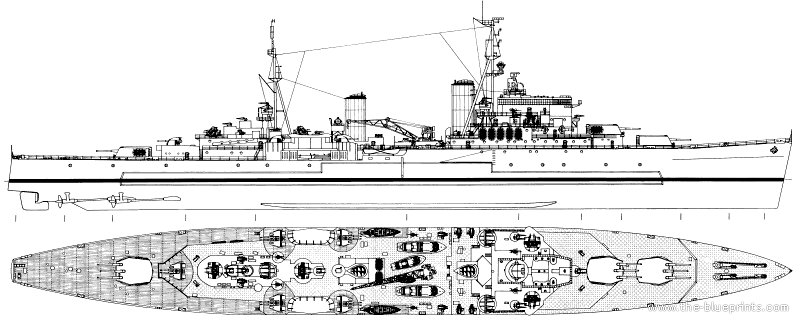
Basic specifications in 1941 called for just a slight enlargement of the Fiji class: They were to have an extra twin 4-inch turret, replacing “C” turret for more AA capabilities. the Minotaurs however innovated with their far more sophisticated weapon control and advanced command, control and action management. They inaugurate whad is now the operation room control of modern surface combatants.
Hull and general design

Compared to the Fijis, the new design was very close, based on 8,800 tons standard dispacement and 11,130 tons full load, compared to 8,530 long tons (8,670 t) standard and 10,450 long ton FL for the Fijis. The third, HMS Superb, displaced 8,885 tons standard and 11,560 tons full load. Their dimensions were the same however, with 555.5 ft (169.3 m) in lenght, and 63 ft (19 m) in beam. Only Superb went for a broader beam at 64 ft (20 m). Draught however went up to 17.25 ft (5.26 m) versus 16 ft 6 in (5.03 m) on the Fijis (Crow Colony).
Armour protection layout
The scheme chosen was essentially a repeat of the previous Fijis, with slight improvement however on deck protection repartition, but figures remained the same.
Belt: 3.25–3.5-inch (83–89 mm)
Main Deck: 2-inch (51 mm)
Main turrets: 1–2-inch (25–51 mm)
Bulkheads: 1.5–2-inch (38–51 mm)
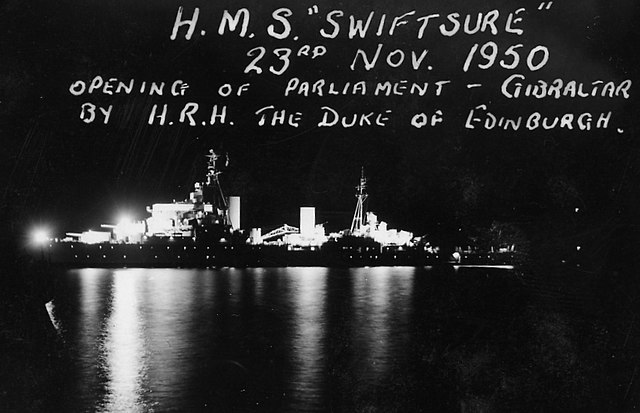
HMS Swiftsure at the opening of the Parliament at Gibraltar, November 1950.
Powerplant
On this chapter also, no revolution was awaited. The new 12 cruisers were given a powerplant based on four propellers, driven by four shaft Parsons steam turbines and fed by four Admiralty-type three drum boilers. Performances wise this enabled a top speed of 31.5 knots (58.3 km/h), range of 2,000 nautical miles (3,700 km) at 30 knots (60 km/h) or 8,000 nautical miles (15,000 km) at 16 knots (30 km/h) based on 1,850 tons of fuel oil. This is on average comparable to the Fiji’s 10,100 nmi (18,700 km; 11,600 mi) at 12 knots (22 km/h; 14 mph).
Armament
In this chapter however, the greates changes occured, although not in types, and for the early bunch of three cruisers. They were still a repeat of the Fijis, but the sacrifice of “C” turret was seen also on the later Fijis when completed. Surface combat was less of a priority than AA defence.
As completed they had three triple triple BL 6-inch Mk XXIII guns (152.4 mm), semi-dual purpose, five dual purpose 4-inch/45 QF Mk 16 HA guns, four quad QF 2 pdr “pom pom” batteries, six single 40 mm Bofors anti-aircraft guns, and two triple 21-inch (533 mm) torpedo tubes. This was modified a lot after completion and postwar (see later).
Main: 3×3 BL 6-inch Mk XXIII
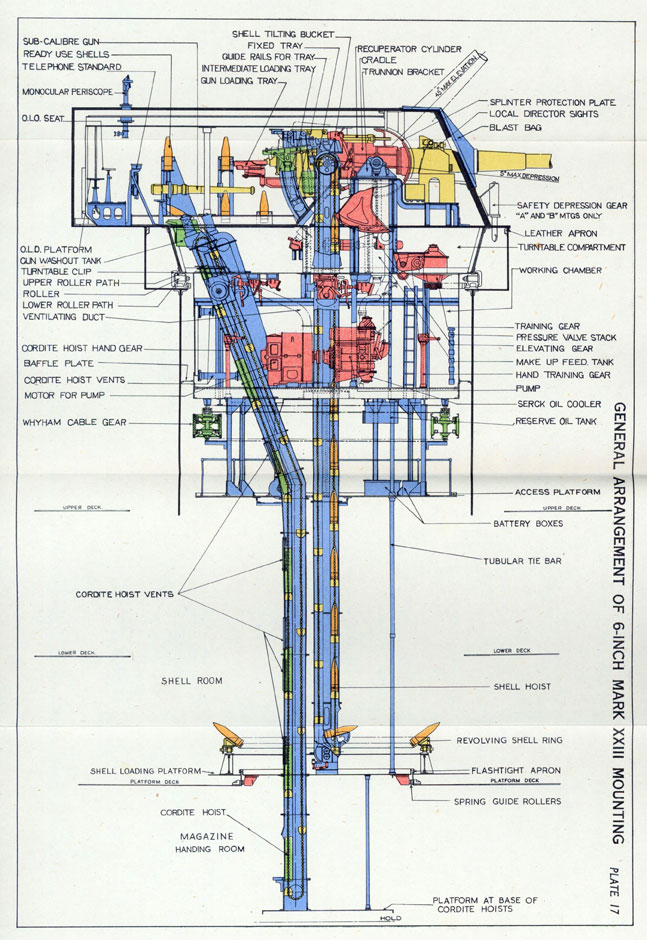
TheBL 6-inch Mk XXIII saw plently of service on many classes already, from the Leander class, Arethusa, Town, Fiji. 300 inches long (7.6 m), weighting 7 tons, they fired a 112 Ibs (51 kgs) shell at 2760 fps at 25,480 yards (23,300 m). Barrel life was around 1,100 rds. Loading needed to have the guns at +12.5 degrees. 60° elevation was possible with the the Mark XXI turrets. The next Mk XXIII used the “long trunk” ammunition hoist system for 5 rpm (Fiji).
Secondary: 5×2 4-in/45 QF Mk16 HA
Another great “classic” from 1936 widely used in the Royal Navy and staple of the light dual purpose battery found on cruisers of that era. They came in two twin turrets placed amidships on either side of the cruisers, close to the aft mainmast. The 4-in (101.6 mm) had the following caracteristics:
Barrel & breech 4,495 lb (2,039 kg), 180 inches (4,572 mm) (45 cal) long
Shell: Fixed QF 35 pounds (15.88 kg) HE 38.25 pounds (17.35 kg) S.A.P.
Breech: vertical sliding-block hydro-pneumatic recoil 83 cm (33 in)
Elevation dependent -10° +80° on H.A. (mark XIX mount)
Traverse 360° mounting dependent
Rate of fire: 15–20 rounds per minute
Muzzle velocity: 2,660 feet per second (811 m/s)
Maximum range: 19,850 yards (18,150 m) at 45°
AA Ceiling: 39,000 feet (11,890 m) at 80°
AA complement: Oerlikon and Bofors
4×8 2-pdr pompom: Another typical ordnance choice, the “compact”, quadruple barrel Vickers 2-pounders (40 mm) on Mark VII mount was less performing than the Bofors, but not manually loaded with clips but rather a short steel-link belt, ensuring a longer burst.
Rate of fire: 115 rpm at 700-732 m/s (2,300 – 2,400 fps)
Effective firing range, ceiling: 3,960 m (13,300 ft)
Maximum surface range: 6,220 m (6,800 yd)/701 m/s (2,300 ft/s)
It should be added as HCMS Ontario had eight single 40mm/39 2pdr QF Mk VIII, in addition to its quad pompom, not Swiftsure.
20mm Oerlikon:
HMS Swiftsure was completed with “only” four quad 40mm/39 2pdr QF Mk VIII pompom but also eight twin 20mm/70 Oerlikon Mk II/IV, and siw single 20mm/70 Oerlikon Mk II/IV AA guns, and kept her two triple 533mm (21-in) TT banks. They were the exact same as for the Colony class.
In 1945, HCMS Ontario would have four 40mm/39 removed in favour of 40mm/56 Bofors Mk III.
As for Swiftsure, in August 1945 she saw the removal of all her twin 20mm/70 AA guns and six single, replaced by thirtheen single 40mm/56 Bofors Mk III.
In 1946 she still had here four quad 40mm/39 Mk VII pompom and torpedo rubes, as well as an upgraded electronics suite: Type 277, Type 281B, Type 282, Type 283, Type 284, Type 285, Type 293 radars.
Sensors and Combat Command
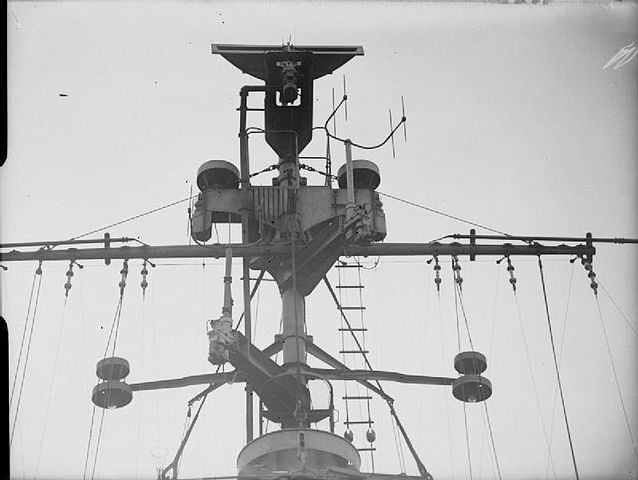
Type 293 radar on HMS Swiftsure
There were the main innovations of the class. The Minotaur were the most advanced cruisers of the RN in terms of centralized fire control and command, multiple threat responses, wlel served by a brand new generation of radars. This all combined greatly improved their capabilities against any threat, surface or aerial, with greater accuracy as ever, faster response and better management of multiple threats at once. They would have been the perfect escort for the British Pacific Carrier Force against the Kamikaze threat if deployed in time.
HMS Swiftsure was completed with the following:
Type 277 radar: The Type 277 4.5 ft (1.4 m) 500 kW frypan surface search and secondary aircraft early warning radar derived from the Type 271. 2950 ±50 MHz (S-band), PRF 500 Hz, Beamwidth 6.2º, Pulsewidth 1.8 or 0.7 µs, RPM 16 rpm, Range 11 NM (1.9–20.4 km)
Type 281B radar: Compared to the 281, it had a better transmission and receiving antennas, short-pulse feature removed. Max detection 20,000 feet (6,100 m) or 120 nautical miles (220 km; 140 mi).
Type 282 radar: Decimetric (50 cm) FCR for Bofors 40 mm and pom-pom, Hazemeyer and twin Yagi antennas. Mechanical ranging panel 5000yd display.
Type 283 radar: The Type 283 was a maritime fire control radar, UHF band, operational in September 1942, in service until 1947.
Type 284 radars: Main armament FCR, for ranging and shot-spotting with lobe switching, bearing readings. Likely Type 284P.
Type 285 radars: AA fire control radar with HACS directors/rangefinder, ranging panel L12. Yagi antenna with separate Tx/Rx. Likely Type 285P, 25yd RMS range accuracy.
Type 293 radars: Improved Type 277/276, better cover and air warning. Stabilised “cheese” antenna 6 feet (1.8 m), AUR.
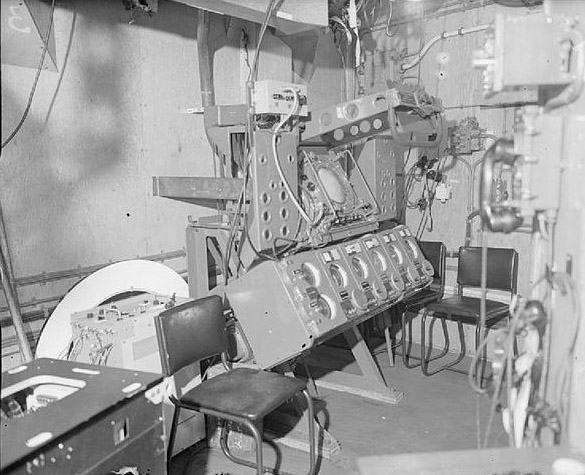
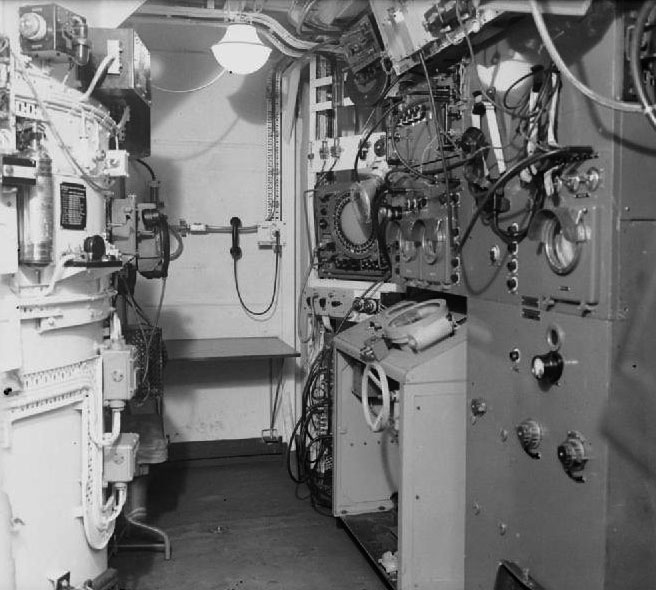
Radar Cabin on HMS Swiftsure
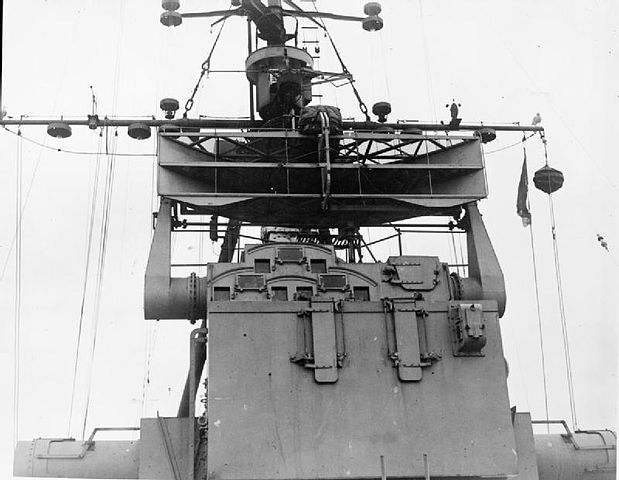
The FCS with its 274 radar

Old author’s HMS Swiftsure in 1944

Swiftsure 1944, From Pinterest
HMS Swiftsure 1944 specifications |
|
| Dimensions | 169,3 m long, 19,20 m large, 6,30 m |
| Displacement | 8 800 t. standard -11 130 t. FL |
| Crew | 630 |
| Propulsion | 4 shafts Parsons turbines, 4 Admiralty boilers, 72 500 shp. |
| Speed | 31.5 knots, Range 10,000 nautical at 14 knots. |
| Armament | 9 x 152 (3×3), 10 x 102 (5×2), 16 x 40 AA Bofors (4×4), 6 x 533 mm TTs (2×3). |
| Armor | See notes |
| Crew | 960 |
General Assessment: From 12 “Fiji-Repeats” to four classes:
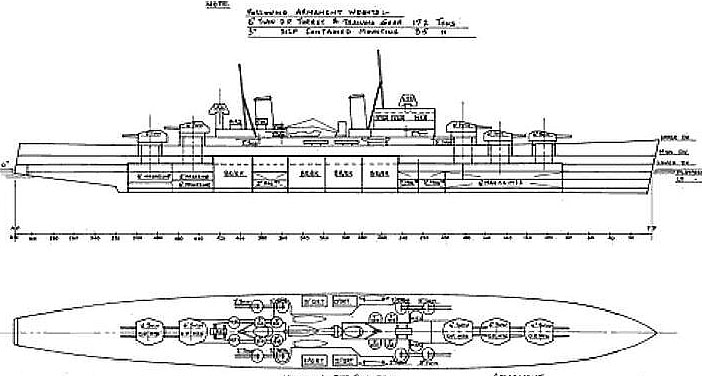
By 1944 the design evolved, and now there were as much as four distinct sub-classes:
1-HMS Swiftsure was completed with the brand new and sophisticated Type 274 lock-and-follow radar, greatly improving accuracy and allowing the main dual purpose 6-in guns a rapid target acquisition. Minotaur followed this design.
2-HMS Superb was a second sub-class which inaugurated an even more advanced Type 275 radar, enabling anti-aircraft fire control, but it was still less advanced than the system completed for the Battle-class destroyers. She stayed alone in her class.
3-Tigers: The third sub-class became the Tigers, and their differences were marked early in their design evolution: They had a completely different main battery with the introduction of three triple Mk 24 6-inch turrets which were “real dual purpose”, as they elevated up to 60° and automatically tracked and followed targets thanks to their Type 274/275 radar control.
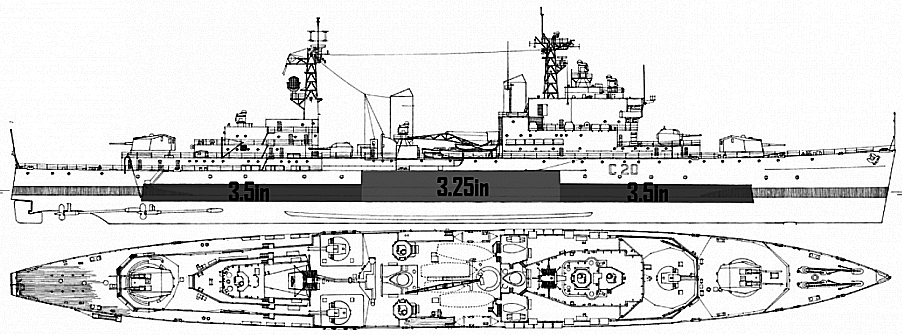
4-HMS Hawke, the fourth of the Tiger class, albeit close to completion in 1946 was suspended as in the meantime were developed the Mk 26 automatic twin 6-inch guns. She became her own, fourth sub-class, but eventually cancelled and BU on the slip, a government decision to save money which was criticized by the Navy, which needed modern cruisers (rather than modernizing worn out WW2 stock cruisers) for the difficult postwar context.
The Tiger-class cruisers evolved even further, as two were converted as helicopter and hybrid missile cruisers dubbed “helicopter and command cruisers” in the 1970s, but had a short career overall. They became the very last British cruisers ever.
Read More/Src
Books
Brown, D. K. & Moore, George (2003). Rebuilding the Royal Navy: Warship Design Since 1945. NIP
Campbell, N.J.M. (1980). “Great Britain” section, Chesneau, Roger (ed.). Conway’s All the World’s Fighting Ships 1922–1946.
Colledge, J. J.; Wardlow, Ben & Bush, Steve (2020). Ships of the Royal Navy: Complete Record. Barnsley, Seaforth Publishing.
Friedman, Norman (2010). British Cruisers: Two World Wars and After. Barnsley, UK: Seaforth Publishing.
Murfin, David (2010). “AA to AA: The Fijis Turn Full Circle”. In Jordan, John (ed.). Warship 2010. NIP
Raven, Alan & Roberts, John (1980). British Cruisers of World War Two. NIP
Whitley, M. J. (1995). Cruisers of World War Two: An International Encyclopedia. Cassell. NIP
Links
world-war.co.uk/
on battleships-cruisers.co.uk
en.wikipedia.org Minotaur-class_cruiser
en.wikipedia.org World_War_II_British_naval_radar
web.archive.org brit_cr_swiftsure.htm
old-forum.warthunder.com hms-tiger
Videos
By Drachinfels, and see also HMAS Ontario
Model Kits
HP model resin 1:700 hms swiftsure could be a good base, but it’s the only one i know of.
Wartime Modifications
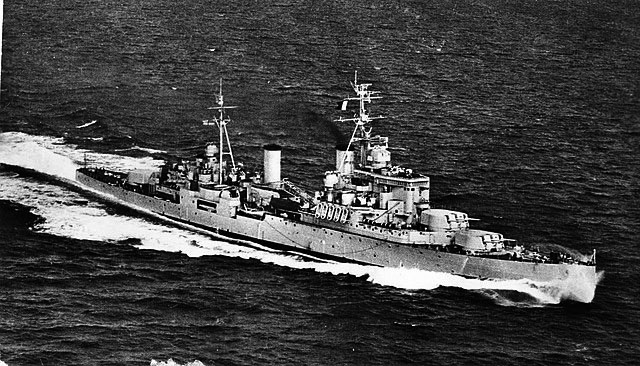
HMS Swiftsure underway
HMS Swiftsure was completed with sixteen twin and six single 20 mm guns until changed in the summer of 1945 and HMCS Ontario (ex-Minotaur) was completed the same, but later modified to all Bofors. Superb was not completed until after the end of hostilities, and had a close-range complement of eight single 40 mm Mk III, two single 2-pdr pompom, four twin 20 mm Oerlikon plus two single.
After a collision with HMS Diamond in the West Indies on 16 September 1953, the lead ship, Swiftsure was largely rebuilt on the same scheme as HMS Belfast in 1956–59. It was largely completed when she was placed in reserve.
The planned modernization called for keeping her triple 6-in gun turrets, and two twin 4-inch guns (now obsolete) and her pair of L/60 Bofors but now controlled by a six-channel MRS8 FCS from the USN. The 1953 modernization plan was more ambitious, as she was to have the new twin 3-inch/70 AA. It was rejected due to the complete rework of all her electrical network, reinforcing her hull and increase her beam to 63 feet (19 m). The admiralty proposed to have her rebuilt as a fourth Tiger class, but it was gutted by the 1957 naval review as all other modernization plans (see later). Part of the reasons were her largely experimental twin 3-inch/70 mounts, considered already unreliable compared to the USN equivalent. A more limited update of both Swiftsure and Superb with new Bofors mounts was also cancelled. It was the cost of completing the Tiger-class cruisers at £35 million was was unsustainable politically, the press also raising the issue of guns jamming. Instead of completing Swiftsure and stopping Lion and Blake in 1960, when the US and USSR considered conventional cruisers obsolete, meant the ship was instead sold for BU.
Career of the Class
 HMS Swiftsure
HMS Swiftsure
Swiftsure’s Pacific Campaign
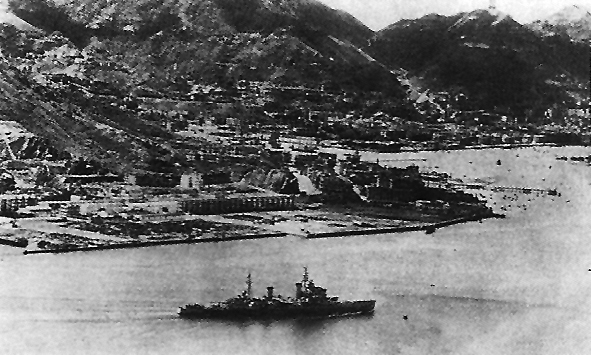
HMS Swifsure entering Hong Kong in August 1945
Swiftsure was laid down at Vickers-Armstrong on 22 September 1941 she was launched on 4 February 1943 and completed on 22 June 1944. After the usual shakedown and sea trials, initial training, she joined the Home Fleet and when declared ready, assigned to the Eastern Fleet. From November 1944 she joined the British Pacific Fleet. Her Pacific campaign was to escort the core of British carriers in the whole Okinawa Campaign in March to May 1945 and in June, the last carrier raid on Truk. The British Pacific Fleet operated as part of Task Group 111.2 and the cruisers, including Swiftsure were used for shore bombardment missions. On 30 August 1945, as the war was already over, this detached group was sent to Hong Kong, this time escorting Colossus class carriers, to accept the Japanese surrender. Due to her radar facilities and command center, she became flagship of the British Pacific Cruiser Squadron. Later she was selected by Admiral Cecil Harcourt as his signature ship during the Japanese surrender.
Swiftsure’s Cold War (1947-1953)
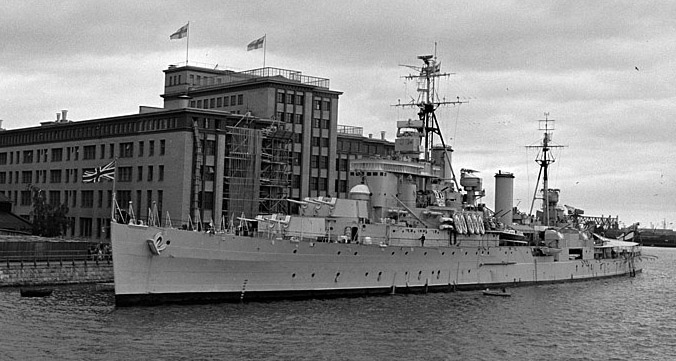
In Helskini, July 1952
In 1946, Swiftsure became flagship of the 4th Cruiser Squadron. In 1951, she retaook this role for the 2nd Cruiser Squadron. She was updated for better commonality with HMS Superb, including three ‘Glasshouse’ Directors type fitted with the Type 275 radar as well as the new Type 960M Long Range Air Warning and more modern battery of 40 mm light AA guns in the postwar “Boffin” and “Buster” mountings.
In 1953, she took part in the Coronation of Queen Elizabeth II’s fleet review. On 29 September 1953, she collided with the destroyer HMS Diamond. A fire started in her bridge cable trunk, and that crippled all her electrical cabling down to the operations room and foremast. This urged a major refit in February 1957 at Chatham, and this enabled her to be upgraded to the new Tiger class standard.
A controversial refit and modernization
The refit notably asked for six twin L70 40 mm Bofors and as the conversion progressed in August 1959, she received a new bridge and lattice masts when the government decided to cancel the modernization. The Parliament stated indeed in 1962 the cost was too much for what was considered an obsolete ship. Original estimates were 4 million pounds. Worst still, her colision damage was not surveyed and seemed more serious during the refit, needed extra work which further delayed the modernisation. So after 1 million pounds and facing far higher costs it was decided to pull the plug.
By April 1960 a Chatham shipyard photo shows Swiftsure with her three turrets reinstalled, completion good enough for six channel AA fire control system easy to install, as the twin 4-inch turrets. The latter however paled in comparison to the USN twin 3/50 (on HMS Victorious) or the Tiger’s own twin 3-inch/70. Estimations were that 0.5 million pound conversion to AC power alone already. The 1957 Defence Review led to cancel the 40mm L70 mounts for the Greenlight (later Seacat) missile.
Long story short, her refit was expensively slowe. By early 1958 the new bridge appeared to have compressed the hull down to 18 inches (46 cm) and she needed to be internally renforced below the new bridge as for Belfast. They were intended to carry data links to carriers with an even larger operations room for the Type 965 radar and Type 184 sonar planned in 1957 for Swiftsure and Superb. There was no other solution at some point to rebuilt the hull partly in 1958-1959 structurally. When complete the old armament was deemed obsolete to fit but new armaments needed a conversion from DC to AC current for another cost. There were also discission to fite 3/70 AA turrets but rising costs saw strong opposition in the press and Parliament. Part of the solution tocover costs was to sell HMS Ceylon and Newfoundland to Peru, stopping the Swiftsures reconstruction and commission HMS Lion earlier than scheduled with partial modernisation. All for completing the two Tigers. Still, there were alternative plans for converting Swiftsure to a helicopter carrier in 1958 but after what happen it was ludicrous.
In November 1960 discussions to convert her to the Seaslug missiles or helicopter carrier were still on the table for the Admiralty which needed her as one of the RN’s few modern and modernised cruiser hulls. One plan was to have her completely flattened with a large deck over hangar to carry 10–12 helicopters but at £7 million pounds, later downgraded to an hybrid solution, until she was eventually sold to Inverkeithing yard (Thos. W. Ward) on 17 October 1962 for scrapping. The partial helicopter carrier conversion were ported on the HMS Blake and Tiger not to waste study time.
 HMS Minotaur
HMS Minotaur
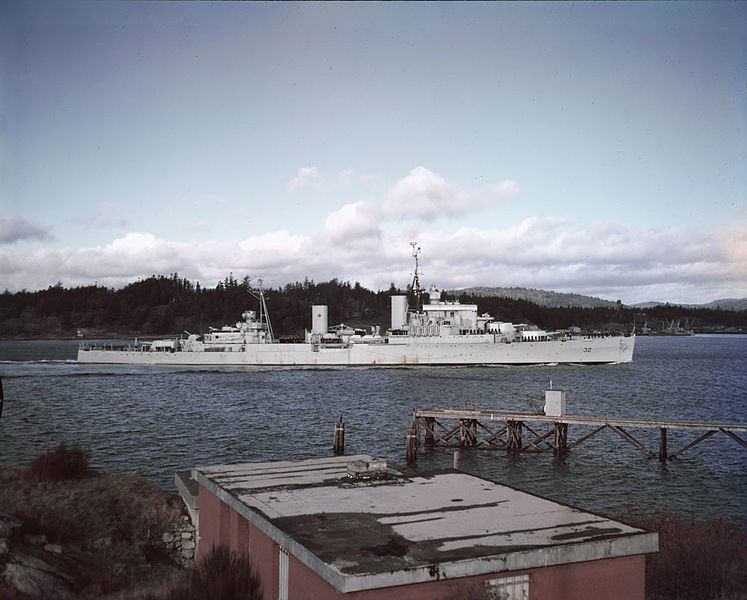
Ordered to Harland & Wolff and laid down on 20 November 1941, launched 29 July 1943 but transferred to the Royal Canadian Navy by July 1944, commissioned on 25 May 1945 as HMCS Ontario.
Like her sister Swiftsure she departed for the pacific, and toured Hong Kong, Manila and Japan in 1946. In October 1948, she teamed up with the HMAS Cayuga, Athabaskan, Crescent and frigate Antigonish to Pearl Harbor. In January 1949 she took part in alarge exercise with the carrier HMAS Magnificent, Haida, Athabaskan and Antigonish with US and RN ships in the Caribbean Sea. In February 1951 she trained in Australia with the RAN. In October she went on the east coast with the Duke of Edinburgh aboard. In 1952 she toured South America. In June 1953 she was at the Coronation Fleet Review. In January 1954 she made another Pacific campaign. By 1955 this was in Europe followed by North and South America. She was paid off on 15 October 1958, sold to Mitsui in Japan in 1960.
 HMS Superb
HMS Superb
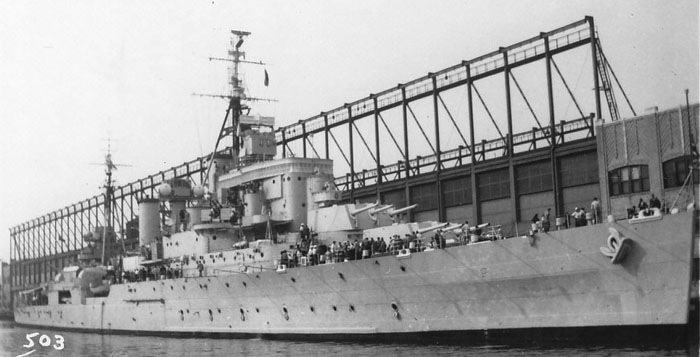
HMS Superb berthed,date unknown. Src
Superb was laid down at Swan Hunter on 23 June 1942, launched on 31 August 1943 and completed on 16 November 1945, after V-Day. She missed WW2 entirely but was to have a cold war career.
She was involved in the Corfu Channel Incident in 1946 (Fired upon by Yugoslavian Troops) and in 1953 took part in the Fleet Review (Coronation of Queen Elizabeth II). She became flagship, Rear Admiral Sir Herbert Packer, and was refitted in 1955–1956. Like her sister she was scheduled for a full modernization in 1957 but instead for cost-saving measures she was decommissioned in December 1957. Listed for disposal in 1959 she was sent at the Dalmuir yards and sold to Arnott Young on 8 August 1960 for BU.
Plans for her modernisation, like her sister Swiftsure were considered, but abandoned after the 1957 defence review and apart the Tiger class, no modernisations was approved afterwards. Plans for conversion as missile cruisers or helicopter cruisers were all ditched. Another reason for abandonment of the modernization was that it was consider prewar construction was of better quality compared to wartime’s; She would need otherwise a considerable reincorcement of the hull, immense increase in power and complete rework of her electrical network for the new radar suite, new derricks, new bridge as her sister, but this was never carried out.
 HMS Hawke
HMS Hawke
HMS Hawke was ordered to HM Dockyard, Portsmouth and laid down by 1 July 1943. However construction was suspened, and eventally cancelled in March 1946 after little work has been done. She was broken up on slipway. The reasons for this were realocation of all workers and resource to the more urgence Light Fleet Carrier program.
 HMS Bellerophon
HMS Bellerophon
Bellerophon was at first planned as Tiger, then renamed Blake when ordered and laid down in Vickers-Armstrong in August 1944. As another new cruiser was to be completed in a modernized design under the same name, she was again renamed HMS Bellerophon, but this mad little difference as construction was suspened. She was eventually Cancelled in 1946 and broken up on slipway like Hawke.
 HMS Blake
HMS Blake
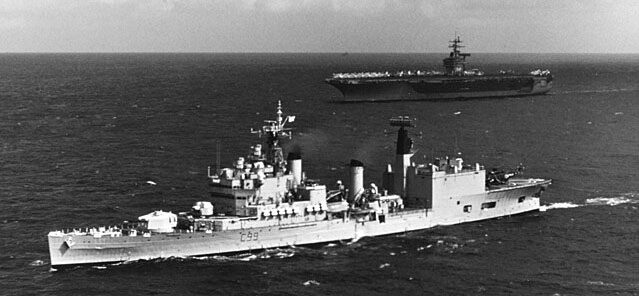
HMS Blake and Nimitz in the channel, 4 October 1975
She was ordered at first as HMS Tiger, at Fairfield, and laid down on 17 August 1942. Worked progressed well until it was decided to convert her with a new design? Work was suspended, pending realocation of resources, but she was eventually launched on 20 December 1945 to free the slipway, now renamed HMS Blake. Rather than scrapping her, it was decided to convert her to yeat another modernized design for a completion planned in 1947-58 at first, then 1960. She became the one of the brand new Tiger-class cruisers, which will be studied in a separate post in the future.
After numerous delays and at the stagerring cost of £14,940,000, HMS Blake was accepted into service on 8 March 1961. She was active until December 1979 and sold for BU.
 HMS Defence
HMS Defence

HMS Defence was started at Scotts on 24 June 1942 and launched on 2 September 1944. Construction was suspended due to other priorities, and she was redesigned twice, in late war and postwar, as a Tiger class cruiser. Commissoned after a colstly reconstruction and modernization on 20 July 1960, she was decommissioned by December 1972 and sold for BU after missing Blake and Tiger’s modernization as helicopter cruisers, due to cost concerns. 12 years of service for £14,375,000 of taxpayer money.
 Bellophoron (ii)
Bellophoron (ii)

HMS Bellerophon second of the name was ordered as HMS Blake at John Brown. She was laid down on 1 October 1941 but work was suspended until she was lauched on 25 October 1945 to free the slipway. Postwar instead of completion to the last design, she was completely redesigned and built as the lead ship of the Tiger-class cruisers, and renamed HMS Tiger. She was the less costly to built at £12,820,000 and first commissioned on 18 March 1959, and second to be decommissioned, on 20 April 1978, after being rebuilt a second time as helicopter cruiser.
 HMS Mars
HMS Mars
Mars was planned but never ordered (no date given) to any yard, received no pennant, and was simply Cancelled in 1946 as Hawke and Bellorophon.
Paper successors: The Neptune class (1944)
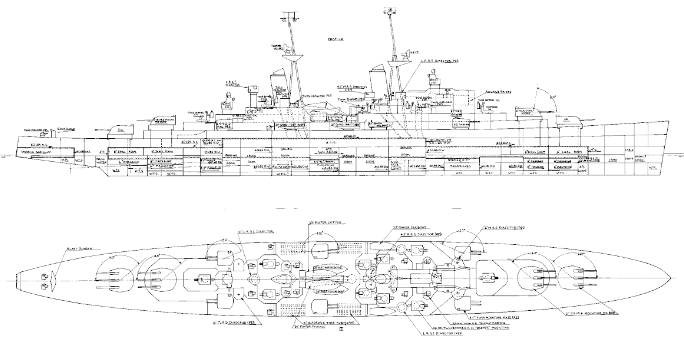
The Neptune class were proposed to succeed to the Minotaur class, a brand new design with complete wartime departure from the pre-war treaty-bound Fiji class on which the Swiftsure were based. These were developed at first as small anti-aircraft (AA) cruisers with up to eight 5.25 in (133 mm) dual-purpose guns (N2 design) in July 1943 and with four twin 5.25-inch turrets over 8,650 long tons (8,790 t) standard, approved in the 1944 construction programme. By October 1943, First Lord of the Admiralty Sir Dudley Pound resigned and Andrew Cunningham scrapped the project, and instead planned a diametrally opposed large cruiser. He described it as an “improved Belfast” with the same battery of twelve 6-inch guns, rose to 18,700 long tons (19,000 t) deep load and 662 ft (202 m) o/a in lenght for a Beam of 76 ft (23 m) and draught of 24 ft 9 in (7.54 m), 108,000 shp (81 MW) and 33 knots but the same armament panoply of twin 4.5 in DP guns, Bofors and Oerlikons plus four quad TT banks.
A bit equivalent to the US Clevelands but larger, they had a complement of 1,351 officers and ratings and were fitted as flagships. Named Neptune, Centurion, Edgar, Mars and Minotaur, they were replaced in the 1944 construction programme intended for the war in the Pacific which was expected to end in 1946-47 at tha stage. However pressure from resources, competing workforce hours diverted elsewhere had the project delays with some hopes of laying down to keels by November 1945 (meaning a completion in 1947 at best, 1950 at worst). But now with the war over, priorities shifted drastically. With none ordered yet, by February–March 1946 the Sea Lords drawning the 1947 ship programme decided to cancel this class as completely obsolete. Attention focused on modernizations and rebuilt the Tiger class. See also.

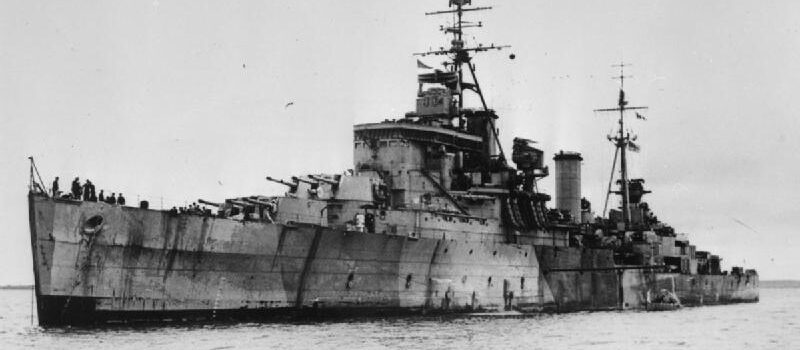

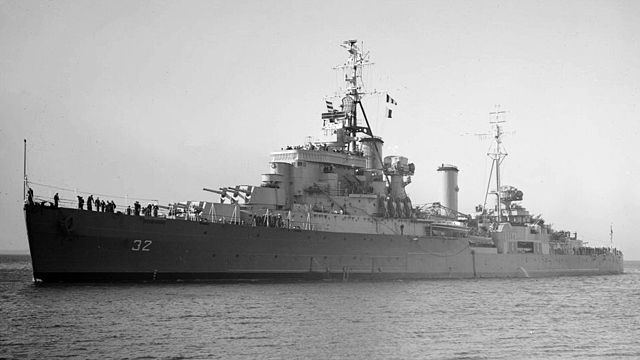
 Latest Facebook Entry -
Latest Facebook Entry -  X(Tweeter) Naval Encyclopedia's deck archive
X(Tweeter) Naval Encyclopedia's deck archive Instagram (@navalencyc)
Instagram (@navalencyc)





 French Navy
French Navy Royal Navy
Royal Navy Russian Navy
Russian Navy Armada Espanola
Armada Espanola Austrian Navy
Austrian Navy K.u.K. Kriegsmarine
K.u.K. Kriegsmarine Dansk Marine
Dansk Marine Nautiko Hellenon
Nautiko Hellenon Koninklije Marine 1870
Koninklije Marine 1870 Marinha do Brasil
Marinha do Brasil Osmanlı Donanması
Osmanlı Donanması Marina Do Peru
Marina Do Peru Marinha do Portugal
Marinha do Portugal Regia Marina 1870
Regia Marina 1870 Nihhon Kaigun 1870
Nihhon Kaigun 1870 Preußische Marine 1870
Preußische Marine 1870 Russkiy Flot 1870
Russkiy Flot 1870 Svenska marinen
Svenska marinen Søværnet
Søværnet Union Navy
Union Navy Confederate Navy
Confederate Navy Armada de Argentina
Armada de Argentina Imperial Chinese Navy
Imperial Chinese Navy Marinha do Portugal
Marinha do Portugal Mexico
Mexico Kaiserliche Marine
Kaiserliche Marine 1898 US Navy
1898 US Navy Sovietskiy Flot
Sovietskiy Flot Royal Canadian Navy
Royal Canadian Navy Royal Australian Navy
Royal Australian Navy RNZN Fleet
RNZN Fleet Chinese Navy 1937
Chinese Navy 1937 Kriegsmarine
Kriegsmarine Chilean Navy
Chilean Navy Danish Navy
Danish Navy Finnish Navy
Finnish Navy Hellenic Navy
Hellenic Navy Polish Navy
Polish Navy Romanian Navy
Romanian Navy Turkish Navy
Turkish Navy Royal Yugoslav Navy
Royal Yugoslav Navy Royal Thai Navy
Royal Thai Navy Minor Navies
Minor Navies Albania
Albania Austria
Austria Belgium
Belgium Columbia
Columbia Costa Rica
Costa Rica Cuba
Cuba Czechoslovakia
Czechoslovakia Dominican Republic
Dominican Republic Haiti
Haiti Hungary
Hungary Honduras
Honduras Estonia
Estonia Iceland
Iceland Eire
Eire Equador
Equador Iran
Iran Iraq
Iraq Latvia
Latvia Liberia
Liberia Lithuania
Lithuania Mandchukuo
Mandchukuo Morocco
Morocco Nicaragua
Nicaragua Persia
Persia San Salvador
San Salvador Sarawak
Sarawak Uruguay
Uruguay Venezuela
Venezuela Zanzibar
Zanzibar Warsaw Pact Navies
Warsaw Pact Navies Bulgaria
Bulgaria Hungary
Hungary

 Bundesmarine
Bundesmarine Dutch Navy
Dutch Navy Hellenic Navy
Hellenic Navy Marina Militare
Marina Militare Yugoslav Navy
Yugoslav Navy Chinese Navy
Chinese Navy Indian Navy
Indian Navy Indonesian Navy
Indonesian Navy JMSDF
JMSDF North Korean Navy
North Korean Navy Pakistani Navy
Pakistani Navy Philippines Navy
Philippines Navy ROKN
ROKN Rep. of Singapore Navy
Rep. of Singapore Navy Taiwanese Navy
Taiwanese Navy IDF Navy
IDF Navy Saudi Navy
Saudi Navy Royal New Zealand Navy
Royal New Zealand Navy Egyptian Navy
Egyptian Navy South African Navy
South African Navy






























 Ukrainian Navy
Ukrainian Navy dbodesign
dbodesign